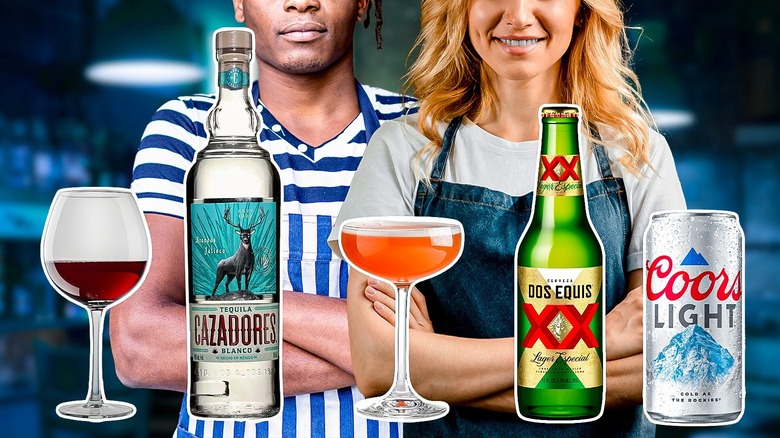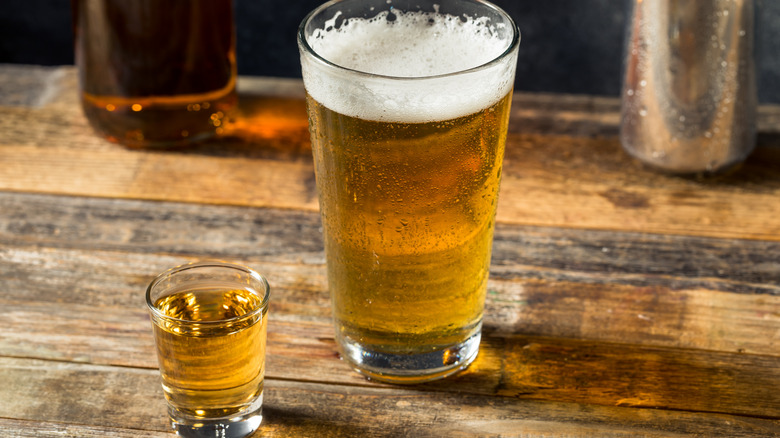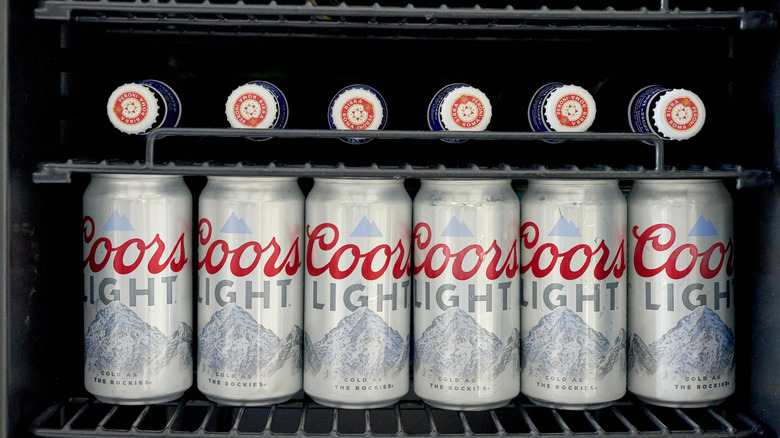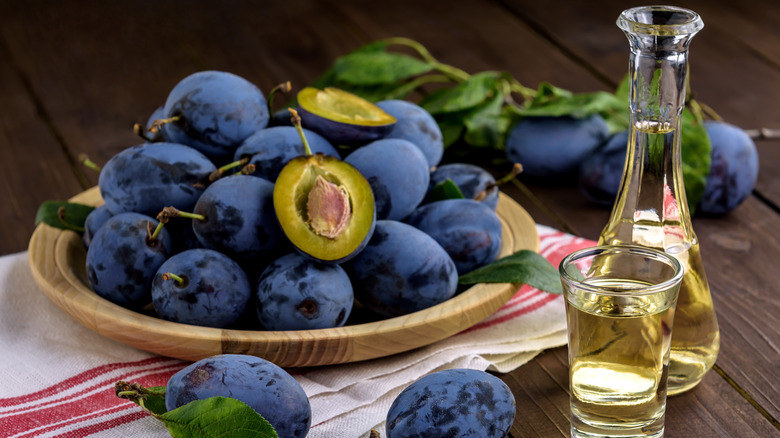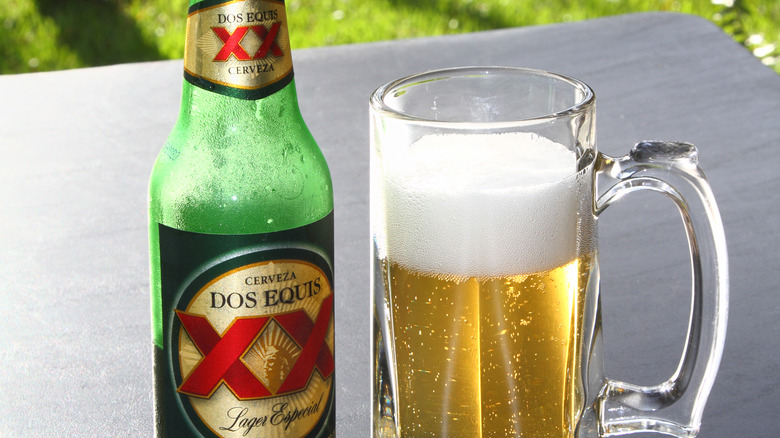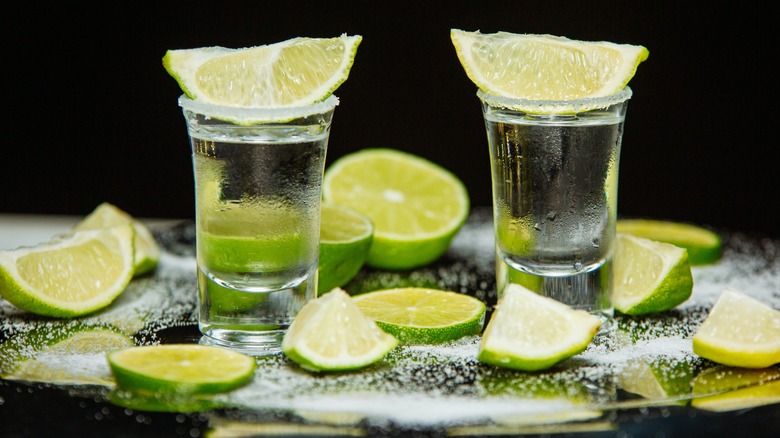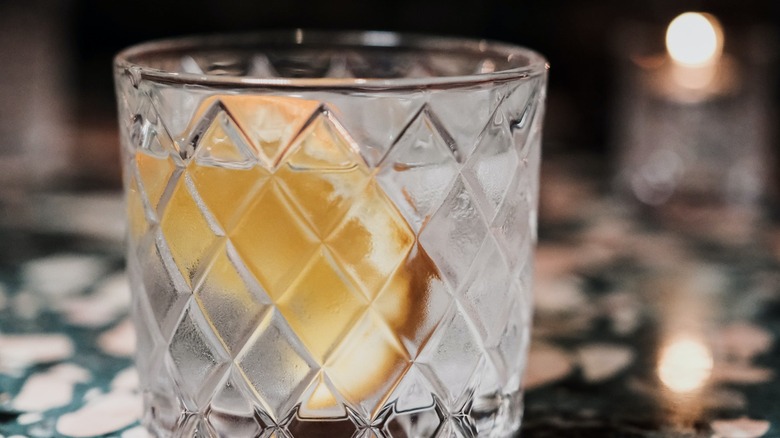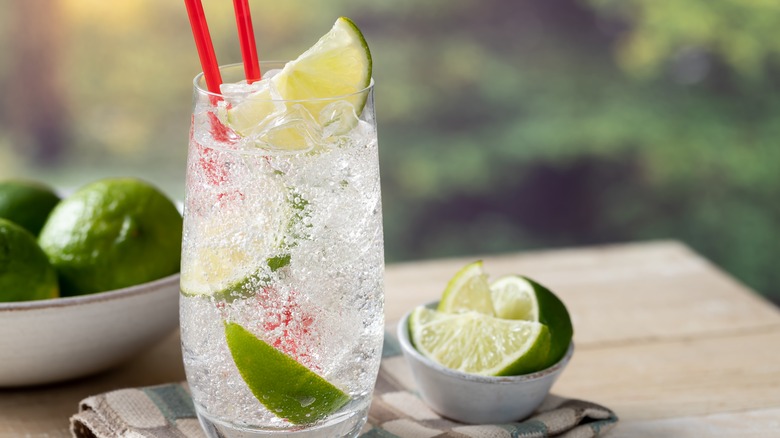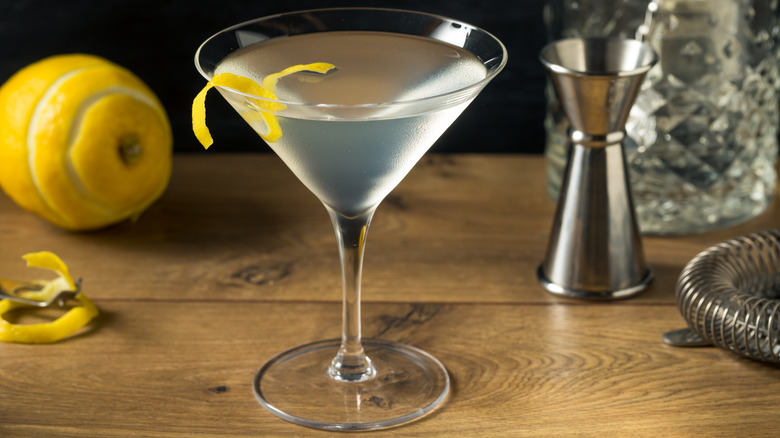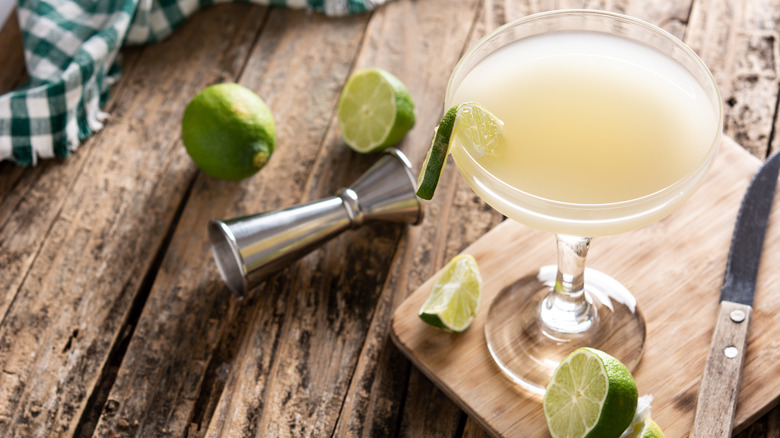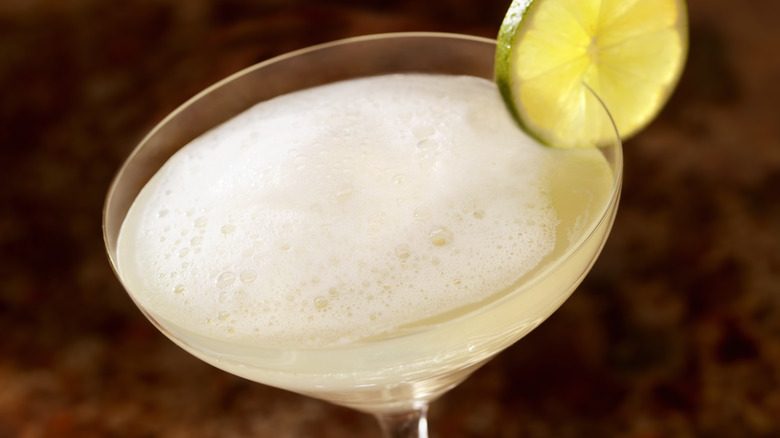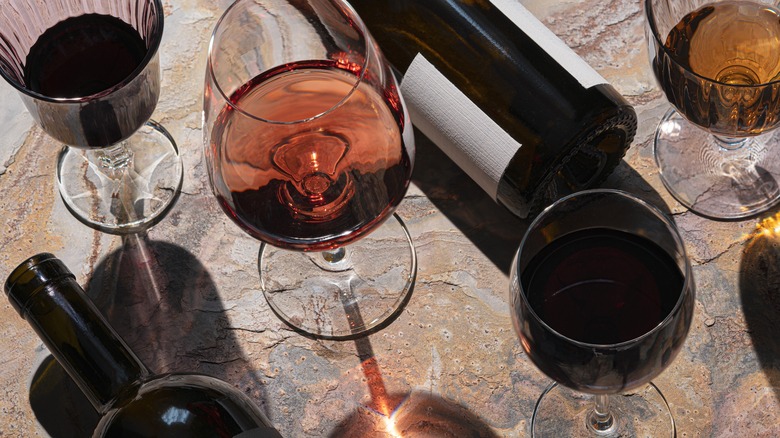What Do Bartenders Prefer To Drink? We Asked A Few
Being surrounded by your work all the time can make you kind of averse to it, and believe it or not, this is even true of bartenders. All day they're throwing drinks together, complex or not, and by the end of their shift, they just want to relax and keep it simple. On a celebrated day off, they tend to know exactly what they want when they're on the other side of the bar. Once bartenders are done working they want one of two things: some peace and quiet, or to join the party. I've personally never seen anything in between and definitely didn't have a middle ground during my bartending and serving days.
There are a few types of post-shift bartenders, but generally speaking, there are those who will throw back a sip of just about anything the moment they plop down at the bar, and then there are those who will only be satisfied by one drink, whatever that may be. It's perfectly reasonable for bartenders to be particular, as they're essentially professional taste testers. There's a certain camaraderie that comes with working in the restaurant world, which means off-duty bartenders reserve their requests for complicated cocktails to slow nights. But under the ideal circumstances, whether it's chilled tequila, a Coors Light, or some seltzer and lime, every bartender has a drink of choice.
Boilermaker
A boilermaker, or a beer and a shot, is the harmonious duo that bartenders are hard-pressed to resist. It provides a little taste of everything and the best of both worlds. The unique term is derived from just what one would guess: boilermakers themselves. The drink (or technically two) was allegedly a beloved choice of 19th-century miners after a hard day's work.
Bartenders are serving up drinks and dropping checks regularly, so they're well-versed in where the profit margins lie in the bar world. They can spot "boilermaker" and know it's likely the best deal on the menu without even reading to the end. Being indecisive is expected from someone who's had their hands in about twenty different liquors on any given night. When you see hundreds of people sip their drinks and react with "ooohs" and "ahhs," how are you supposed to decide what drink will make your eyes light up? The beauty of a boilermaker is that you don't have to choose just one.
The drink pairing has developed a few nicknames over the years, varying from region to region. Some call it a "happy meal," rightfully so, while others order it as a "one and one." It's so prevalent in Philadelphia it's referred to as the "Citywide Special."
Cheap domestic beer
There's comfort in consistency, and comfort is exactly what bartenders crave after a night of mayhem at the bar. Say what you want about cheap beer, but it will always deliver the same taste. The price point does have a pull, but the domestic beer craving is rooted in more than just a bargain. There is a reason so many domestic beers rank high on favored lists, and that's familiarity. Domestic brew is typically mass-produced and with a production line so mainstream, processes are locked in, helping to produce the same flavor each time. Budweiser is a shining example, as it's been a mainstay since 1857 and fans can still recognize that distinct taste anywhere.
Whether that first sip is nostalgic or simply thirst-quenching, basic beer is certainly one of the more popular drinks, especially for bartenders. Some will be satisfied with a Budweiser served in any vessel, while others believe the beer should only be consumed from a bottle, and they're willing to die on that hill. At the same time, we also have those who are satisfied with whatever's on tap, and the bartenders who will happily crack open the first thing they grab in the cooler. It can be difficult, or sometimes impossible, to meet every customer's expectations, so there's something extremely satisfying about meeting your own.
Eau de vie
Eau de vie, or "water of life," is a French fruit brandy deeply rooted in Western Europe's identity. Aside from a few anomalies, Eaux de vie are brandies made with fruits other than grapes. There are a few exceptions to the rule, like Marc de Bourgogne, a grape-made Eau de vie famously used to brine the pungent Epoisses. Its success as a wash for cheese rinds makes sense given the brandy's rich, fruity flavor. Eaux de vie are more commonly fermented from pears, plums, raspberries, and cherries, with dozens of more fragrant blends. Regardless of the fruit being used, Eau de vie has recently become beloved by bartenders for its fruity flavor without being overly sweet. These brandies are typically unaged, giving them a crystal clear look and a warm finish. From what we've seen, Eau de vie is becoming the new Fernet for industry folks, kicking that digestif to the curb, which seems to be past its heyday.
Nicky Auletta of Bar Futo in Portland, Maine shares his coworkers' love of Eau de vie — St. George's Aqua Perfecta Basil, to be exact. It's still fruit-forward but with complex layers of Genovese and Thai basil that give it an incredibly unique bite. At Bar Futo, it's the staff's go-to companion alongside a Coors Light. This is an unexpected match made in heaven, according to Auletta.
Dos Equis with lime juice
While creating new concoctions isn't every bar's forte, it doesn't mean the staff can't get creative, even if only for their own benefit. Those working in more divey bars with limited options are pros at thinking outside of the box. If they have a hankering for a sour beer but the menu is lacking, they'll make it happen.
The absence of sour beer at Tomaso's, a friendly watering hole in Portland, Maine, has never stopped staff from scratching that itch. Longtime bartender Ben Poland shared what they dubbed the "poor man's sour beer," which involves Dos Equis and a ridiculous amount of lime juice. The result is refreshing, easy-drinking, and shockingly similar to a light, funky sour. The beauty of having the means to experiment means exactly that: endless experimentation. Oftentimes those trials turn out surprisingly successful and don't just make it on the bar's menu, but menus all over the world. We've never seen the "poor man's sour beer" specifically featured on any menus, but we've definitely noticed folks pouring hefty amounts of lime juice into their beer and thought, "Hmm ... they may be in the industry."
Silver tequila, neat
Tequila is a liquor with depth and variety, making it an attractive drink of choice with a lot to offer. One small sip can linger on right up until the next, with powerful tingling properties. The Mexican liquor is a go-to for cocktails like margaritas and palomas, but with such a distinct flavor it can (and should) be enjoyed solo as well. When chatting with current bartenders about their go-to liquor, tequila was one of the first options out of their mouths. If not whiskey, the majority of them opt for a nice, clean tequila to sip on, and always a blanco. Gold tequila often has a more potent flavor due to the aging process, whereas silver tequila is younger and a bit more delicate, making it a nice spirit to slowly savor. Cazadores and Espolon are excellent brands to consider, and bartender approved. Sauza is also a nice bottom-shelf option with a middle-shelf flavor.
When we worked excruciating doubles with only thirty minutes or so to decompress before the dinner shift began, a coworker would always recommend a shot of espresso, a cigarette, and a shot of tequila as a "pick me up." Certainly not advised for a multitude of reasons, but we'd be lying if we said we never gave it a whirl (minus the cigarette). It's a surefire way to awaken the senses, but best when work isn't on the horizon.
Mezcal
We can see Mezcal battling an identity crisis with how often it gets jumbled in with tequila. While certainly a member of the tequila family, it is without a doubt a spirit of its own. Due to its popularity, many assume tequila is the older of the two, but tequila is actually just a type of mezcal. Both liquors are derived from agave, but mezcal has a lot fewer rules, which means the flavor profiles can go a lot farther. In order to dub itself tequila, a liquor has to be made with agave tequilana Weber or Weber blue agave, whereas mezcal can take advantage of practically any variety of the agave plant.
Eric of Doris in Bed Stuy, Brooklyn has been reaching for Zacate Limon and 5 Sentidos Pechuga de Mole Poblano as of late, sipped alongside a beer of contrasting quality. He's a great advocate for five-stars and dive bars, with a steadfast love of both elite mezcal and cans of Natty Daddy. To be a bartender is to have vast tastes and somehow extremely particular preferences at the same time. When you've tasted it all, you know what you like.
Flavored seltzer water
It can be hard to remember as you shoot the breeze with a bartender that they're at their job, working, just like anyone else. Bars often feel like a party, welcoming you the moment your butt hits the bar seat — that's their design, to make you feel great. But if bartending has taught us one thing, it's the truth in the saying, "You don't need alcohol to have fun." A good amount of bartenders we chatted with had a lot to say about drinking, but today their drink of choice often doesn't provide a buzz. They bid adieu to the party lifestyle of their younger days, but never the industry.
There's a difference between enjoying a few drinks and letting a few drinks enjoy you, a line that bartenders have a keen detection for as a huge (unwelcomed) aspect of their job. As a dedicated Portland bartender, Ben has bounced between a few of the city's favorite establishments and currently works at Tomaso's, slinging wings and drinks to the busy crowd. These days, he chugs seltzers on the daily, preferably Polar pink apple or lemon. Plain old soda can get repetitive fast, and there are only so many Roy Rogers and Shirley Temple's one can take. If Ben wants a little kick, his preferred nonalcoholic beer is a Lagunitas Hoppy Refresher.
Gin martinis
After a long week of shaking cocktails for others, bartenders often crave a flawless martini. It's second nature to just grab something ready-made or quick to pour, but bartenders deserve drinks made with love too. Everyone has differing taste buds, but gin seems to be the proven alcohol of choice among bartenders. While not a bartender, the late playwright Noel Coward knew his martinis and enthusiastically vouched for gin, once famously quipping, "A perfect martini should be made by filling a glass with gin then waving it in the general direction of Italy." A well-crafted gin martini can do wonders and is commonly a bartender's day-off treat.
Just like different beer and wine varieties, cocktails can be perfectly paired with types of cuisines. As far as martinis go, seafood is often on the table. Perhaps it's the elite quality that both allude to, often being seen as the most expensive option on the menu and, in turn, the most exquisite. Maine-based bartender Sofia Proia says that at Scales, a five-star seafood establishment tucked away on Portland's pier, they enjoy wet martinis with a very good vermouth such as Miro Dry Vermouth or Carpano Bianco Vermouth.
Classic daiquiris
Hearing "daiquiri" can often spark visions of swim-up bars, tall hurricane goblets, fruity garnishes, and frozen swirled berries. After hearing the unanimous daiquiri praise from bartenders, we quickly realized frozen strawberry daiquiris were our main point of reference. They're so often seen as a beachy summer drink, but a classic daiquiri is actually quite elegant and doesn't require any fancy equipment. Despite the ultra-sweet evolution of the daiquiri, the original isn't that sweet, or even fruity. The cocktail is rather subtle and has more tartness than anything else. With just three simple ingredients — rum, lime juice, and simple syrup —this cocktail is a bartender's dream. It's easy to make, easy to drink, and doesn't include any pricey top-shelf elements.
Allegedly conceived in 1898 by an American living in Cuba, the daiquiri made its way to the U.S. in the early 1900s, and it didn't take long for it to be embedded into the bartender's bible. When it's not the tropical counterpart to Pain Killers and Hurricanes, the lime cocktail is more reserved and sophisticated.
Daiquiri Time Out (DTO shots)
Even strict beer drinkers will break out and try a fun cocktail every now and then, but it's not something they gravitate towards. What steers most away from a delicious cocktail like a daiquiri is often the heavy sugar content. Whether the taste itself is too candy-like or they fear a hangover, seeing 16 ounces of sugary mixed drink can be off-putting. That being said, everyone still wants a little taste, and that's when DTO shots come in. Abbreviated from Daiquiri Time Out, the concept is basically a mini daiquiri.
This drink is nothing new, as Metro talked it up back in 2016, noting it as the industry's drink of choice in Boston. Allegedly it came about as a solution to defuse a heated exchange, as a literal time-out. The quick daiquiri sip was a means to an end, but now it's an invitation to pause and savor the delicious sweetness with friends. The origins of the cocktail are fuzzy, but the concept was born somewhere in Massachusetts and flourished in Boston, particularly within the restaurant industry. The hype made its way up the coast, even years later. DTO shots may not be trending all over the globe, but they certainly are in southern Maine, where bartenders throw them back regularly at Room For Improvement.
Wine
You can never go wrong with the classics. A nice glass of wine can be the most comforting reward after a grueling day. Given the endless varietals, the flavors are extremely diverse, and there's something for everyone. Even those who generally avoid wine always seem eager to try a recommended glass or pair something special with dessert. There's always an occasion for wine, and most bartenders would tend to agree. Those who don't drink very regularly often opt for a glass of wine on special occasions. Like Nicky, who often looks forward to a tiny glass of red wine to sip on as he closes out his night at Bar Futo.
We've found bartenders to be picky when ordering drinks in some instances, and aggressively lenient in others. Unless it's paired with a gourmet meal, wine is often one they leave up to chance. Even the acclaimed wino bartenders in our circle will simply order a "white wine" with no specifics. Typically that will get you a house pour that's perfectly acceptable and budget-friendly. These wine-loving bartenders can recognize a great wine, a good wine, and a mediocre wine, and they love them all the same.
